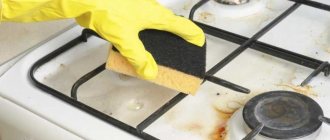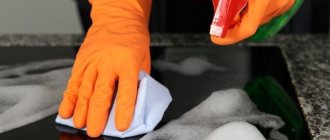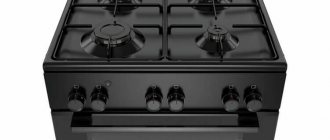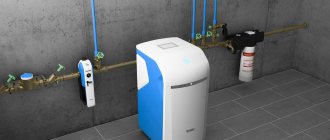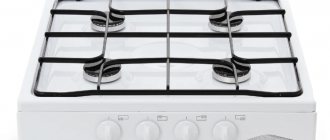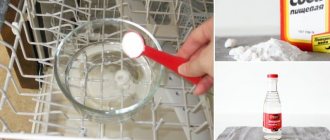Geyser - principle of operation, causes of clogging
A instantaneous gas water heater is essentially a heat exchange device. Its main element is a special pipe circuit. A water stream flows through it and is heated by an open external flame of a gas burner. Modern models turn on automatically - as soon as the mixer valve opens, ignition occurs and thermal energy is transferred to the walls of the circuit, and from them to the flow. As a result, the user receives hot water at the outlet.
Despite the simplicity of the design and operation scheme, the operation of such a device constantly creates harmful factors that interfere with normal functioning - first of all, these are:
- Carbon deposits are on the outer walls of the heat exchange circuit. It impairs heat transfer from the burner to the water, reduces efficiency, and leads to excessive fuel consumption.
- Scale – builds up on the inner walls of the heat exchanger. It is formed as a result of the decomposition of salts dissolved in water and the precipitation of a solid insoluble precipitate. Reduces flow, reduces pressure, impairs performance.
Scale build-up in the heat exchanger significantly reduces the performance of the heater Source bigam.ru
- Soot - solid products of gas combustion inevitably settle on the burner itself and the igniter. The flame periodically goes out, the combustion intensity decreases, performance deteriorates, and there is a risk of gas leakage.
In addition, depending on the quality of the water, other impurities may settle in the heating device - rust, silt, sand, etc. To eliminate their influence, periodic and timely proper cleaning of the gas water heater is required.
When is it time to clean the gas water heater?
The following signs indicate that the gas water heater requires cleaning:
- the main burner ignites with difficulty, and sometimes with a strong bang;
- the heater starts, but does not work for long, the main burner quickly turns off;
- from below, from under the casing, soot begins to fall;
- The unit operates at maximum power, but the water barely heats up.
Signs for cleaning the column
Popping noise in the combustion chamber indicates that a large amount of gas has accumulated in it before ignition. This means that the problem is in the igniter, which ignites the fuel with a delay. A visual sign is a weak wick flame, colored yellow, this is a sign of a clogged nozzle. The solution to the problem is to clean the igniter. In most models of columns, the ignition unit can be easily disconnected from the main burner and debris can be removed from the nozzle.
The overheating and draft sensors are triggered by soot accumulated between the fins of the heat exchanger. The cross-section of the gas-air path is significantly reduced, and the water temperature increases. In this case, it is necessary to clean the radiator and the walls of the combustion chamber from soot. Extreme contamination is when flakes of soot fall out from under the decorative steel apron, covering the floor or objects under the heater.
Cleaning the igniter
Poor heating of running water is a consequence of a decrease in the flow area of the heat exchanger pipes, whose inner walls are covered with a thick layer of scale. A sign of total “overgrowth” of the internal passage of the tubes is a noticeable decrease in the water pressure at the outlet of the column with its normal pressure at the inlet. These salts contained in tap water intensively deposit on the heated surfaces of pipes and form a durable thick coating. Then the geysers, or more precisely, the heat exchangers, are cleaned of scale using the flushing method.
Signs you need cleaning
The primary symptoms that the device is clogged and needs urgent cleaning are the following:
- The pressure of hot water is noticeably lower than that of cold water. Occurs due to a narrowing of the pipe lumen as a result of overgrowing with deposits.
- There is a regular shutdown of the device immediately after startup. The reason is the formation of carbon deposits on the ignition element.
- The level of water heating has decreased while the power of the device remains unchanged. It is a consequence of external fouling of the heat exchange circuit by carbon deposits.
- The time for heating water to the set value has increased. Occurs due to a decrease in burner flame power.
When the heat exchanger is clogged, the water flows extremely slowly and hardly heats up. Source cosmo-frost.ru
- There is noise inside the device during operation. Extraneous sounds are a consequence of uncharacteristic boiling of water inside the heat exchanger due to loss of sensitivity of contact thermal sensors with the walls of the thermal circuit.
- Switching off the device upon command from thermal protection sensors. Due to scale build-up, the walls of the heat exchange circuit begin to overheat.
In addition, when the heater is turned on, a strong bang may occur, indicating that the burner ignition is not working properly, and soot may simply begin to fall out from under the housing. All these signs indicate an urgent need to clean the gas water heater. Otherwise, the situation may get out of control, which will lead not only to damage to the device, but also to a leak of household gas with the ensuing serious consequences.
Important! Before starting cleaning procedures, the instantaneous water heater must be disconnected from the water and gas supply.
Before starting cleaning work, be sure to turn off the water and gas supply Source baltgaz.ru
Cleaning the heat exchanger without dismantling
Even when you are not confident in your knowledge of technology, you can flush the gas water heater if you use this simple method:
- Once you remove the cover, stop the water supply.
- Next, you need to open the hot tap (any one located closer to the device).
- Then you need to disconnect the flow tube from the heat exchanger. It unscrews and moves slightly to the side.
- When you loosen the heat exchanger nut, water will begin to flow out of it. You don't need to drain a lot. It is enough to limit yourself to 1 liter.
- Then you need to put the hose on the radiator inlet, lift it above the level of the column, placing a funnel in the hole. Slowly pour the selected solution into it. It is advisable to leave it for several hours. If the gas is turned on, the liquid will heat up on the burning pilot light. This will speed up the reaction.
- Place a bucket or basin under the tap and turn on the water supply to the tap. This needs to be done gradually.
Notice the liquid coming out of the hose. If the pressure is good and the water contains a small amount of sludge, the procedure was successful. Otherwise it must be repeated.
Tip: each device has its own characteristics, so look at the technical data sheet before cleaning the column. Find information about the volume of water in the heat exchanger and drain a little more liquid.
In critical situations, you don’t have to resort to disassembling the radiator or its components at all, which will help save time and money. To do this, you will need two tubes with ½" fittings at the end, approximately 1.5 m long.
- Before you begin manipulation, turn off the water and gas.
- The first tube must be connected to the inlet of the heat exchanger, the second to the outlet. 1.5 liter bottles, closed with caps, are attached to the free ends of the hoses. One of them should be empty, and the second should be filled with washing liquid.
- Place the first container on the floor, and gradually lift the full one up to facilitate the flow of water. Loosen the cap of the bottom bottle slightly - this will allow air to get inside, this will make the process easier.
- Change the position of the containers and continue until the water flows easily.
Features of cleaning main components
In domestic conditions, the owner of a gas instantaneous water heater is allowed to clean the following main parts:
- The burner surface is free from soot and deposits.
- Heat exchanger against scale build-up.
- The surfaces of the components inside the case are free of dust.
- The water supply part from clogging.
In addition, it would be useful to check the condition of the water intake module, the correct operation of traction sensors, the presence of lubrication of critical components and the tightness of all connections.
In this case, the most significant and often leading to malfunctions are the following column elements:
- Water intake.
- Heat exchanger.
- Burner.
Let's look at the specifics of cleaning each of them.
See also: Catalog of companies that specialize in engineering systems (heating, water supply, sewerage and others) and related work
Water intake
The water entry into the heat exchange circuit pipeline begins through a special water inlet equipped with a strainer. Its purpose is to protect the unit from various kinds of mechanical impurities coming with the water flow.
The water inlet of the geyser is disassembled and cleaned Source cosmo-frost.ru
Cleaning the filter element located in front of the geyser heat exchanger is possible in the following 2 ways:
- Mechanical.
In most cases, the strainer becomes clogged with sand, rust particles and other sediment. Therefore, the fastest and easiest way to restore its functionality is to disassemble it and then clean it according to the following algorithm:
- The water and gas supply is turned off.
- The instrument panel is being disassembled.
- The water receiver is removed.
- The housing cover is removed.
- The filter is cleaned directly with a brush and a stream of water.
- If necessary, replace the membrane (if during disassembly it turns out to be curved rather than flat).
- After cleaning and drying, the filter is installed in place.
- The device is being assembled.
If the membrane fails - it breaks or bends - you can replace it with a new silicone-based model. Unlike traditional ones, it will last much longer.
The cross-section of the heat exchanger pipe becomes overgrown with scale during operation Source terman-s.ru
- Chemical.
It is not always possible to clean the pores of the mesh filter with a stream of water or a brush. Therefore, different types of acids are used:
- 9% vinegar.
- 20% lemon.
- Salt 5-8%.
- Sulfur 5%.
In order for the mesh to be cleaned of stubborn particles, it is enough to place it in hydrochloric or sulfuric acid for 10 minutes, or for about 1-1.5 hours in citric or acetic acid. After settling in an acidic environment, it must be thoroughly rinsed and, if necessary, cleaned with a brush.
Note! Working with acids is allowed in a well-ventilated area or outdoors, observing safety precautions and using personal protective equipment - gloves, goggles.
Heat exchanger
To restore normal operation of the gas water heater, it is also necessary to clean the heat exchanger from external carbon deposits and internal scale. The following methods are available for this purpose:
- From carbon deposits mechanically.
Cleaning the heat exchange circuit requires mandatory disassembly with preliminary shutdown of the gas and water mains. The procedure is performed using some kind of mechanical device.
Cleaning the heat exchanger housing with a brush Source teploburg.ru
How to clean a radiator
You will do the best job if you completely remove the radiator from the unit. Many will say that washing the device by removing the heat exchanger is unnecessary manipulation. But by working this way, you reduce the risk of damage to the unit. To avoid mistakes, act consistently:
- Turn off the gas and water. Open the closest hot tap.
- Unscrew both union nuts. Depending on the model, you will have to disassemble other elements of the column; cover the burners with a cloth to protect them from soot. When finished, carefully remove the assembly.
- Place it in a convenient place, for example, in a bathtub, after covering it with something so as not to damage the enamel.
- Further cleaning the heat exchanger does not cause any difficulties. The radiator is cleaned of soot manually using a brush and detergent. In order to remove scale, pour in a special solution and leave for the required time. Then rinse under running water and dry well.
- Reassemble in reverse order, replacing the O-rings at the pipe joints. Before starting the column, check it for leaks.
- Turn on the water. Since the mixer tap remains open, the heat exchanger fills up. Turn off the water and inspect the connections for leaks. If everything is normal, you can resume the gas supply and check the device in operating mode.
Tip: spray nuts that are difficult to unscrew with a solution to soften hard dirt, such as WD-40.
Features of the use of various means
When deciding what to rinse with and how to clean a geyser from scale and carbon deposits at home, two types of products are used:
- Professional. Special industrially produced products for removing soot, soot, carbon deposits and dissolving scale are widely available today. They should be used strictly according to the factory instructions and recommendations. The disadvantage is the need to buy specially, the high price.
- Folk. This category includes various detergents and acids. They can be used in compliance with the original instructions and safety regulations. Plus – accessibility, minus – a weak effect is possible.
Prevention
In order to reduce the frequency of cleaning and the likelihood of scale formation, it is recommended to observe the following conditions:
- Use a high-quality water filter and monitor its condition. If necessary, clean or replace in time.
- If you use hard water, install special softeners at the inlet.
- Perform preventive cleaning at least once a year, even if there are no obvious signs of clogging of the device.
Advice! In order to flush the gas water heater heat exchanger as completely as possible and in the shortest possible time, a special device is used - a booster. The liquid forcibly circulates along its circuit and quickly corrodes the scale.
Briefly about the main thing
A gas instantaneous water heater contains a coil through which water flows. From the outside it is heated by the open flame of a gas burner. The most common clogging factors are scale, soot, carbon deposits, as well as mechanical particles in the water. The first signs that the device needs cleaning are:
- Reduced hot water pressure.
- Periodic shutdown.
- Reduce heating level.
- Increasing the set temperature period.
- Appearance of noise.
- Triggering of thermal protection sensors.
The owner of the gas water heater is allowed to clean only the water inlet, heat exchanger and burner jets on his own, without disassembling - only a gas service employee has the right to dismantle and clean the ignition installation. In each case, both mechanical and chemical methods can be used using industrial or household means. You can prevent damage to the device due to severe blockage by observing timely preventive measures.
Ratings 0
